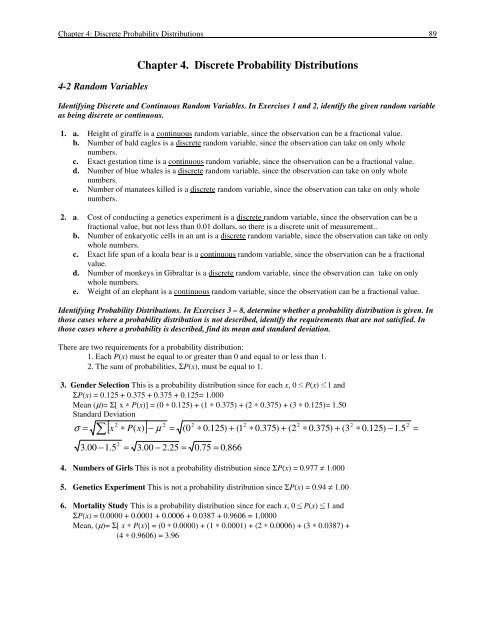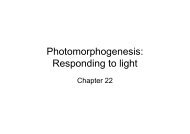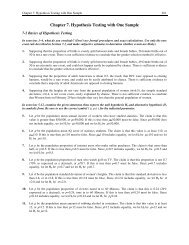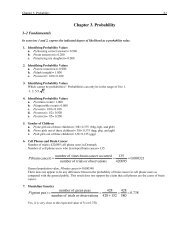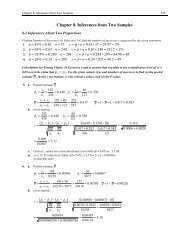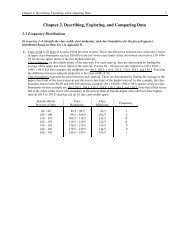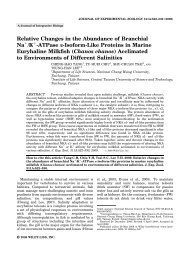Chapter 4. Discrete Probability Distributions
Chapter 4. Discrete Probability Distributions
Chapter 4. Discrete Probability Distributions
You also want an ePaper? Increase the reach of your titles
YUMPU automatically turns print PDFs into web optimized ePapers that Google loves.
<strong>Chapter</strong> 4: <strong>Discrete</strong> <strong>Probability</strong> <strong>Distributions</strong> 89<br />
4-2 Random Variables<br />
<strong>Chapter</strong> <strong>4.</strong> <strong>Discrete</strong> <strong>Probability</strong> <strong>Distributions</strong><br />
Identifying <strong>Discrete</strong> and Continuous Random Variables. In Exercises 1 and 2, identify the given random variable<br />
as being discrete or continuous.<br />
1. a. Height of giraffe is a continuous random variable, since the observation can be a fractional value.<br />
b. Number of bald eagles is a discrete random variable, since the observation can take on only whole<br />
numbers.<br />
c. Exact gestation time is a continuous random variable, since the observation can be a fractional value.<br />
d. Number of blue whales is a discrete random variable, since the observation can take on only whole<br />
numbers.<br />
e. Number of manatees killed is a discrete random variable, since the observation can take on only whole<br />
numbers.<br />
2. a. Cost of conducting a genetics experiment is a discrete random variable, since the observation can be a<br />
fractional value, but not less than 0.01 dollars, so there is a discrete unit of measurement..<br />
b. Number of enkaryotic cells in an ant is a discrete random variable, since the observation can take on only<br />
whole numbers.<br />
c. Exact life span of a koala bear is a continuous random variable, since the observation can be a fractional<br />
value.<br />
d. Number of monkeys in Gibraltar is a discrete random variable, since the observation can take on only<br />
whole numbers.<br />
e. Weight of an elephant is a continuous random variable, since the observation can be a fractional value.<br />
Identifying <strong>Probability</strong> <strong>Distributions</strong>. In Exercises 3 – 8, determine whether a probability distribution is given. In<br />
those cases where a probability distribution is not described, identify the requirements that are not satisfied. In<br />
those cases where a probability is described, find its mean and standard deviation.<br />
There are two requirements for a probability distribution:<br />
1. Each P(x) must be equal to or greater than 0 and equal to or less than 1.<br />
2. The sum of probabilities, ΣP(x), must be equal to 1.<br />
3. Gender Selection This is a probability distribution since for each x, 0 ≤ P(x) ≤ 1 and<br />
ΣP(x) = 0.125 + 0.375 + 0.375 + 0.125= 1.000<br />
Mean (µ)= Σ[ x ∗ P(x)] = (0 ∗ 0.125) + (1 ∗ 0.375) + (2 ∗ 0.375) + (3 ∗ 0.125)= 1.50<br />
Standard Deviation<br />
3.00 −1.5<br />
2<br />
[ x ∗ P(<br />
x)<br />
]<br />
2<br />
σ = ∑ − µ<br />
2<br />
=<br />
=<br />
(0<br />
3.00 − 2.25 =<br />
2<br />
∗ 0.125) + (1<br />
0.75 = 0.866<br />
2<br />
∗ 0.375) + (2<br />
2<br />
∗ 0.375) + (3<br />
2<br />
∗ 0.125) −1.5<br />
2<br />
=<br />
<strong>4.</strong> Numbers of Girls This is not a probability distribution since ΣP(x) = 0.977 ≠ 1.000<br />
5. Genetics Experiment This is not a probability distribution since ΣP(x) = 0.94 ≠ 1.00<br />
6. Mortality Study This is a probability distribution since for each x, 0 ≤ P(x) ≤ 1 and<br />
ΣP(x) = 0.0000 + 0.0001 + 0.0006 + 0.0387 + 0.9606 = 1.0000<br />
Mean, (µ)= Σ[ x ∗ P(x)] = (0 ∗ 0.0000) + (1 ∗ 0.0001) + (2 ∗ 0.0006) + (3 ∗ 0.0387) +<br />
(4 ∗ 0.9606) = 3.96
90 <strong>Chapter</strong> 4: <strong>Discrete</strong> <strong>Probability</strong> <strong>Distributions</strong><br />
Standard Deviation<br />
(0<br />
2<br />
2<br />
[ x ∗ P(<br />
x)<br />
]<br />
2<br />
σ = ∑ − µ<br />
∗0.0000)<br />
+ (1<br />
2<br />
=<br />
∗0.0001)<br />
+ (2<br />
2<br />
∗0.0006)<br />
+ (3<br />
2<br />
∗0.0387)<br />
+ (4<br />
2<br />
∗0.9606)<br />
−3.96<br />
2<br />
=<br />
15.72−3.96<br />
2<br />
=<br />
15.72−15.68<br />
=<br />
0.04 = 0.201<br />
7. Genetic Disorder This is a probability distribution since for each x, 0 ≤ P(x) ≤ 1 and<br />
ΣP(x) = 0.4219 + 0.4219 + 0.1406 + 0.0156 = 1.0000<br />
Mean, µ= Σ[ x ∗ P(x)] = (0 ∗ 0.4219) + (1 ∗ 0.4219) + (2 ∗ 0.1406) + (3 ∗ 0.0156) = 0.75<br />
Standard Deviation<br />
2<br />
[ x ∗ P(<br />
x)<br />
]<br />
2<br />
σ = ∑ − µ<br />
1.1247−<br />
0.75<br />
2<br />
=<br />
=<br />
(0<br />
1.1247−<br />
0.5625 =<br />
2<br />
2<br />
∗0.4219)<br />
+ (1 ∗0.4219)<br />
+ (2<br />
0.5622 = 0.75<br />
2<br />
∗0.1406)<br />
+ (3<br />
2<br />
∗0.0156)<br />
− 0.75<br />
2<br />
=<br />
8. Diseased Seedlings This is not a probability distribution since ΣP(x) = 0.986 ≠ 1.00<br />
9. Gender Selection Technique Effectiveness From Table 4-1<br />
a. P(9)= 0.122<br />
b. P(9 or more)= 0.122 + 0.061 + 0.022 + 0.006 + 0.001 + 0.000= 0.212<br />
c. The probability from part (b) since any outcome 9 or above achieves the same criterion of<br />
being unusually high.<br />
d. No, P(9 or more) is not unusual, P(9 or more) > 0.05. This would happen by chance about one time out of<br />
every five samples. We would conclude there is not sufficient evidence to conclude that the technique is<br />
effective.<br />
10. Gender Selection Technique Effectiveness From Table 4-1<br />
a. P(12)= 0.006<br />
b. P(12 or more)= 0.006 + 0.001 + 0.000= 0.007<br />
c. The probability from part (b) since any outcome 12 or above achieves the same criterion<br />
of being unusually high.<br />
d. Yes, P(12 or more) is unusual, P(12 or more) < 0.05. This would happen by chance only<br />
about seven times out of every 1000 samples. We would conclude there is sufficient<br />
evidence to conclude that the technique is effective.<br />
11. Gender Selection Technique Effectiveness From Table 4-1<br />
a. Include probabilities of 11 or more, P(11 or more)= 0.022 + 0.006 + 0.001= 0.029<br />
b. Yes, P(11 or more) is unusual, P(11 or more) < 0.05. This would happen by chance only<br />
about three times out of every 100 samples. We would conclude there is sufficient<br />
evidence to conclude that the technique is effective.<br />
12. Gender Selection Technique Effectiveness From Table 4-1<br />
a. Include probabilities of 10 or more, P(10 or more)= 0.061 + 0.022 + 0.006 + 0.001= 0.090<br />
b. No, P(10 or more) is not unusual, P(10 or more) < 0.05. This would happen by chance<br />
about nine times out of every 100 samples. We would conclude there is not sufficient<br />
evidence to conclude that the technique is effective.
<strong>Chapter</strong> 4: <strong>Discrete</strong> <strong>Probability</strong> <strong>Distributions</strong> 91<br />
13. Finding Mean and Standard Deviation Possible outcomes of gender of four children:<br />
Outcome # girls (x) Outcome # girls (x)<br />
BBBB<br />
BBBG<br />
BBGB<br />
BGBB<br />
GBBB<br />
BBGG<br />
BGGB<br />
GGBB<br />
GBGB<br />
BGBG<br />
GBBG<br />
0<br />
1<br />
1<br />
1<br />
1<br />
2<br />
2<br />
2<br />
2<br />
2<br />
2<br />
GGGB<br />
GGBG<br />
GBGG<br />
BGGG<br />
GGGG<br />
Number of 0<br />
Number of 1<br />
Number of 2<br />
Number of 3<br />
Number of 4<br />
3<br />
3<br />
3<br />
3<br />
4<br />
1<br />
4<br />
6<br />
4<br />
1<br />
There are 16 possible different outcomes (permutations).<br />
Number of<br />
Girls (x) out P(x)= # girls/16 x ∗ P(x) x 2 x 2 * P(x)<br />
of four<br />
0 1/16= 0.0625 0.0000 0 0.0000<br />
1 4/16= 0.2500 0.2500 1 0.2500<br />
2 6/16= 0.3750 0.7500 4 1.5000<br />
3 4/16= 0.2500 0.7500 9 2.2500<br />
4 1/16= 0.0625 0.2500 16 1.0000<br />
Total 1.0000 ∑[x ∗P(x)] = 2.0 ∑[x 2 ∗P(x)]= 5.0<br />
Mean, µ = Σ<br />
[( x) * P( x)<br />
]<br />
Standard deviation, σ =<br />
= 2.00<br />
4-3 Binomial <strong>Probability</strong> <strong>Distributions</strong><br />
Σ<br />
2<br />
2<br />
2<br />
[ x * P( x)<br />
] − µ = 5.0 − 2.0 = 5.0 − <strong>4.</strong>0 = 1.00 = 1. 00<br />
Identifying Binomial <strong>Distributions</strong>. In Exercises 1 – 8, determine whether the given procedure results in a<br />
binomial distribution. For those that are not binomial, identify at least one requirement that is not satisfied.<br />
There are four requirements for a binomial distribution:<br />
1. There are a fixed number of trials or observations<br />
2. The trials are independent<br />
3. Each trial has two possible outcomes<br />
<strong>4.</strong> The probabilities remain constant for each trial<br />
1. This is not a binomial distribution. The number of trials (people) is not fixed. Possible outcomes are not<br />
classified into two categories; they could be any number. There could be any number of different answers to the<br />
question.<br />
2. This is a binomial distribution, all requirements are met, with only two possible outcomes (answers), “yes or<br />
no”.<br />
3. This is not a binomial distribution. The outcomes (answers) are not classified into two categories.
92 <strong>Chapter</strong> 4: <strong>Discrete</strong> <strong>Probability</strong> <strong>Distributions</strong><br />
<strong>4.</strong> This is a binomial distribution, all requirements are met. The question has a “yes or no” answer.<br />
5. This is a binomial distribution, all requirements are met. The outcomes are “male or female”.<br />
6. This is a binomial distribution, all requirements are met. The outcomes are “acceptable or defective”.<br />
7. This is not a binomial distribution. The outcomes (answers) are not classified into two categories. The couples<br />
could have any number of children.<br />
8. This is a binomial distribution, all requirements are met. The outcomes are “yes or no”.<br />
9. Finding Probabilities when Guessing Answers P(wrong) = 4/5 = 0.8, P(correct) =1/5 = 0.2<br />
a. P(WWC) = 0.8 ∗ 0.8 ∗ 0.2 = 0.128<br />
b. Three possible arrangements: WWC, WCW, CWW<br />
P(WWC) = 0.8 ∗ 0.8 ∗ 0.2 = 0.128<br />
P(WCW) = 0.8 ∗ 0.2 ∗ 0.8 = 0.128<br />
P(CWW) = 0.2 ∗ 0.8 ∗ 0.8 = 0.128<br />
c. P( exactly one correct answer in 3 guesses) = P(WWC) + P(WCW) + P(CWW)= 0.128 + 0.128 + 0.128=<br />
0.384<br />
10. Finding Probabilities when Guessing Answers P(W) = 0.75, P(C) = 0.25<br />
a. P(WWCCCC) = 0.75 ∗ 0.75 ∗ 0.25 ∗ 0.25 ∗ 0.25 ∗ 0.25 = 0.0022<br />
6!<br />
(6 − 2)!2!<br />
6 ∗5<br />
∗ 4!<br />
4! 2!<br />
30<br />
2<br />
b. Combinations= P = = = 15<br />
6 2<br />
=<br />
List of two wrong and four correct answers:<br />
WWCCCC, WCWCCC, WCCWCC, WCCCWC, WCCCCW, CWWCCC, CWCWCC,<br />
CWCCWC, CWCCCW, CCWWCC, CCWCWC, CCWCCW, CCCWWC, CCCWCW,<br />
CCCCWW<br />
. P(each outcome)= 0.75 ∗ 0.75 ∗ 0.25 ∗ 0.25 ∗ 0.25 ∗ 0.25 = 0.0022<br />
c. P(four correct out of six guesses)= 15 ∗ 0.0022= 0.0330<br />
Using Table A-1. In Exercises 11 – 16, assume that a procedure yields a binomial distribution with a trial<br />
repeated n times. Use Table A-1 to find the probabilities of x successes given the probability p of success on a<br />
given trial.<br />
11. n= 2, x= 0, p=0.01 0.01 Column, 2-0 Row P(0)= 0.980<br />
12. n= 7, x= 2, p=0.10 0.10 Column, 7-2 Row P(2)= 0.124<br />
13. n= 4, x= 3, p= 0.95 0.95 Column, 4-3 Row P(3)= 0.171<br />
1<strong>4.</strong> n= 6, x= 5, p= 0.99 0.99 Column, 6-5 Row P(5)= 0.006<br />
15. n=10, x= 4, p= 0.95 0.95 Column, 10-4 Row P(4)= 0.000 +<br />
16. n=11, x= 7, p= 0.05 0.05 Column, 11-7 Row P(7)= 0.000 +<br />
Note: for answers 15 and 16, the numbers are greater than zero, but when rounded to three decimal places, they are<br />
0.000.
<strong>Chapter</strong> 4: <strong>Discrete</strong> <strong>Probability</strong> <strong>Distributions</strong> 93<br />
Using the Binomial <strong>Probability</strong> Formula. In Exercises 17-20, assume that a procedure yields a binomial<br />
distribution with a trial repeated n times. Use the binomial probability formula to find the probabilities of x<br />
successes given the probability p of success on a given trial.<br />
17. n=6, x= 4, p= 0.55<br />
P(<br />
x)<br />
=<br />
P(4)<br />
=<br />
( n − x)<br />
6!<br />
∗ 0.55<br />
!4!<br />
( 6 − 4)<br />
n!<br />
∗ p<br />
! x!<br />
∗ q<br />
∗ 0.45<br />
15 ∗ 0.0915∗<br />
0.2025 = 0.280<br />
18. n= 6, x= 2, p= 0.45<br />
P(<br />
x)<br />
=<br />
P(2)<br />
=<br />
( n − x)<br />
( 6 − 2)<br />
n!<br />
∗ p<br />
! x!<br />
x<br />
6!<br />
∗ 0.45<br />
!2!<br />
4<br />
∗ q<br />
n−x<br />
∗ 0.55<br />
15 ∗ 0.2025∗<br />
0.0915 = 0.280<br />
x<br />
2<br />
n−x<br />
6−4<br />
6−2<br />
6 ∗5<br />
∗ 4!<br />
= ∗ 0.55<br />
2!4!<br />
6 ∗5<br />
∗ 4!<br />
= ∗ 0.45<br />
4!2!<br />
4<br />
2<br />
∗ 0.45<br />
2<br />
∗ 0.55<br />
4<br />
=<br />
=<br />
19. n= 8, x= 3, p= 0.25<br />
P(<br />
x)<br />
=<br />
P(3)<br />
=<br />
( n − x)<br />
8!<br />
3<br />
∗ 0.25<br />
!3!<br />
( 8 − 3)<br />
n!<br />
∗ p<br />
! x!<br />
∗ q<br />
n−x<br />
∗ 0.75<br />
56 ∗ 0.01563∗<br />
0.2373 = 0.208<br />
x<br />
8−3<br />
8 ∗ 7 ∗ 6 ∗ 5!<br />
= ∗ 0.25<br />
5!3!<br />
3<br />
∗ 0.75<br />
5<br />
=<br />
20. n= 10, x= 8, p= 0.3333<br />
P(<br />
x)<br />
=<br />
( n − x)<br />
n!<br />
∗ p<br />
! x!<br />
∗ q<br />
n−x<br />
10!<br />
P(8)<br />
= ∗ 0.3333<br />
(10 − 8)!8!<br />
∗ 0.6667<br />
45 ∗ 0.0001523∗<br />
0.4445 = 0.00305<br />
x<br />
8<br />
10−8<br />
10 ∗ 9 ∗8!<br />
= ∗ 0.3333<br />
2!8!<br />
8<br />
∗ 0.6667<br />
2<br />
=<br />
Using Computer Results. In Exercises 21-24, refer to the Minitab display in the margin. The probabilities were<br />
obtained by entering the values of n= 6 and p= 0.167. In a clinical test of the drug Lipator (atorvastatin), 16.7%<br />
of the subjects treated with 10 mg of atorvastatin experienced headaches (based on data from Parke-Davis). In<br />
each case, assume that 6 subjects are randomly selected and treated with 10 mg of atorvastatin, then find the<br />
indicated probability.<br />
21. P(at least 5 have headache)= P(5 or 6)= P(5) + P(6)= 0.0006 + 0.0000= 0.0006<br />
It would be very unusual for 5 out of 6 subjects to get a headache. This would happen only 6 times out of 1000<br />
samples by chance.<br />
22. P(2 or less have headache)= P(0 or 1 or 2)= P(0) + P(1) + P(2)= 0.3341 + 0.4019 + 0.2014= 0.937<strong>4.</strong> It would<br />
not be unusual at all for up to 2 out of 6 subjects to get a headache. This would happen about 94 times out of<br />
100 samples by chance.
94 <strong>Chapter</strong> 4: <strong>Discrete</strong> <strong>Probability</strong> <strong>Distributions</strong><br />
23. P(more than 1 have headache)= P(2 or 3 or 4 or 5 or 6)= P(2) + P(3) + P(4) + P(5) + P(6)=<br />
0.2014 + 0.0538 + 0.0081 + 0.0006 + 0.0000= 0.2639<br />
P(not having more than one headache out of 6) = 1 – P(2, 3, 4, 5, or 6)= 1.0000 – 0.2639= 0.7361). It would<br />
not be unusual to not have more than 1 headache out of 6 patients.<br />
2<strong>4.</strong> P(at least 1 has headache)= P(1) + P(2) + P(3) + P(4) + P(5) + P(6)=<br />
0.4019 + 0.2014 + 0.0538 + 0.0081 + 0.0006 + 0.0000= 0.2639= 0.6658<br />
P(not having at least one headache out of 6) = 1 – P(1, 2, 3, 4, 5, or 6)= 1.0000 – 0.6658= 0.3342). It would not<br />
be unusual to not have at least 1 headache out of 6 patients.<br />
25. Drug Reaction n= 8, p= 0.04<br />
a. x= 3, P(3 out of 8)<br />
P(<br />
x)<br />
=<br />
( n − x)<br />
n!<br />
∗ p<br />
! x!<br />
8!<br />
P(8)<br />
= ∗ 0.04<br />
(8 − 3)!3!<br />
∗ q<br />
∗ 0.96<br />
8−3<br />
56 ∗ 0.000064 ∗ 0.8154 = 0.00292<br />
x<br />
3<br />
n−x<br />
8 ∗ 7 ∗ 6 ∗5!<br />
=<br />
∗ 0.04<br />
5!3!<br />
3<br />
∗ 0.96<br />
5<br />
=<br />
b. x= 8, P(8 out of 8)<br />
P(<br />
x)<br />
=<br />
( n − x)<br />
n!<br />
∗ p<br />
! x!<br />
8!<br />
P(8)<br />
= ∗ 0.04<br />
(8 − 8)!8!<br />
x<br />
∗ q<br />
8<br />
n−x<br />
∗ 0.96<br />
∗ 0.96<br />
1∗<br />
0.00000000000655∗1<br />
= 0.00000000000655 = 0.000<br />
0<br />
=<br />
8!<br />
∗ 0.04<br />
0!8!<br />
c. If all 8 experienced headaches, this would be evidence that this placebo group was certainly different than<br />
the 4% group. It is highly unlikely the all 8 in the placebo group would have a headache.<br />
8<br />
0<br />
=<br />
÷<br />
26. Color Blindness n= 6, x= 2, p= 0.09, P(2 out of 6)<br />
P(<br />
x)<br />
=<br />
( n − x)<br />
n!<br />
∗ p<br />
! x!<br />
∗ q<br />
6!<br />
P(2)<br />
= ∗ 0.09<br />
(6 − 2)!2!<br />
∗ 0.91<br />
15 ∗ 0.0081∗<br />
0.6857 = 0.0833<br />
x<br />
2<br />
n−x<br />
6−2<br />
6 ∗ 5∗<br />
4!<br />
= ∗ 0.09<br />
4!2!<br />
2<br />
∗ 0.91<br />
4<br />
=<br />
27. Acceptance Sampling n= 24, p= 0.04, x= 1 or 0, P(0 or 1)= P(0) + P(1)<br />
P(<br />
x)<br />
=<br />
( n − x)<br />
n!<br />
∗ p<br />
! x!<br />
∗ q<br />
24!<br />
P(0)<br />
= ∗ 0.04<br />
(24 − 0)!0!<br />
n−x<br />
∗ 0.96<br />
24!<br />
1<br />
P(1)<br />
= ∗ 0.04 ∗ 0.96<br />
(24 −1)!1!<br />
x<br />
0<br />
24−0<br />
24−1<br />
24!<br />
∗ 0.04<br />
24!0!<br />
24 ∗ 23! 1<br />
= ∗ 0.04 ∗ 0.96<br />
23!1!<br />
P(0 or 1) = P(0)<br />
+ P(1)<br />
= 0.3754 + 0.3754 = 0.7508<br />
The probability of this shipment being accepted is 0.751.<br />
=<br />
0<br />
∗ 0.96<br />
24<br />
23<br />
= 1∗1∗<br />
0.3754 = 0.3754<br />
= 24 ∗ 0.04 ∗ 0.3911 = 0.3754
<strong>Chapter</strong> 4: <strong>Discrete</strong> <strong>Probability</strong> <strong>Distributions</strong> 95<br />
28. Affirmative Action Programs n=10, x= 9 or 10, p= 0.94,<br />
a. P(9 or 10 out of 10)<br />
P(<br />
x)<br />
=<br />
( n − x)<br />
n!<br />
∗ p<br />
! x!<br />
∗ q<br />
10!<br />
P(9)<br />
= ∗ 0.94<br />
(10 − 9)!9!<br />
10!<br />
P(10)<br />
=<br />
∗ 0.94<br />
(10 −10)!10!<br />
x<br />
9<br />
n−x<br />
∗ 0.06<br />
∗ 0.06<br />
10 ∗ 9!<br />
= ∗ 0.94<br />
1!9!<br />
10−10<br />
10!<br />
∗ 0.94<br />
0!10!<br />
P(9 or 10) = P(9)<br />
+ P(10)<br />
= 0.3438 + 0.5386 = 0.8824<br />
10<br />
10−9<br />
<strong>Probability</strong> that 9 or more graduated is 0.882<strong>4.</strong><br />
=<br />
9<br />
∗ 0.06<br />
10<br />
1<br />
∗ 0.06<br />
= 10 ∗ 0.5730 ∗ 0.06 = 0.3438<br />
0<br />
= 1∗<br />
0.5386 ∗1<br />
= 0.5386<br />
b. P(x ≤ 7)= 1 – P(x > 7)= 1 – [P(8) + P(9) + P(10)]<br />
P(<br />
x)<br />
=<br />
( n − x)<br />
n!<br />
∗ p<br />
! x!<br />
∗ q<br />
10!<br />
P(8)<br />
= ∗ 0.94<br />
(10 − 8)!8!<br />
∗ 0.06<br />
45 ∗ 0.6096 ∗ 0.0036 = 0.0988<br />
x<br />
8<br />
n−x<br />
10−8<br />
10 ∗ 9 ∗8!<br />
= ∗ 0.94<br />
2!8!<br />
8<br />
∗ 0.06<br />
2<br />
=<br />
P(x ≤ 7)= 1 – P(x > 7)= 1 – [0.0988 + 0.3438 + .5386]= 1 – 0.9812= 0.0188<br />
Since P(x ≤ 7) < 0.05, this would be unusual to have only 7 graduate.<br />
29. Identifying Gender Discrimination n= 20, p= 0.5, P(2 or less)<br />
P(<br />
x)<br />
=<br />
0.0001812<br />
( n − x)<br />
n!<br />
∗ p<br />
! x!<br />
∗ q<br />
20!<br />
P(0)<br />
= ∗ 0.5<br />
(20 − 0)!0!<br />
20!<br />
1<br />
P(1)<br />
= ∗ 0.5 ∗ 0.5<br />
(20 −1)!1!<br />
20!<br />
P(2)<br />
= ∗ 0.5<br />
(20 − 2)!2!<br />
x<br />
0<br />
2<br />
n−x<br />
∗ 0.5<br />
20−1<br />
∗ 0.5<br />
20−0<br />
20−2<br />
=<br />
20!<br />
∗ 0.5<br />
20!0!<br />
∗ 0.5<br />
20 ∗19!<br />
1<br />
= ∗ 0.5 ∗ 0.5<br />
19!1!<br />
20 ∗19<br />
∗18!<br />
=<br />
∗ 0.5<br />
18!2!<br />
= 1∗1∗<br />
0.000000953 = 0.000000953<br />
= 20 ∗ 0.5 ∗ 0.00000191 = 0.0000191<br />
∗ 0.5<br />
= 190 ∗ 0.25∗<br />
0.00000381 =<br />
P(2 or less) = P(0)<br />
+ P(1)<br />
+ P(2)<br />
= 0.000000953 + 0.0000191+<br />
0.00018120 = 0.000201<br />
Yes, this result would tend to support evidence that discrimination occurred since by chance this would have<br />
happened about 2 times out of 1000 samples.<br />
0<br />
20<br />
19<br />
2<br />
18
96 <strong>Chapter</strong> 4: <strong>Discrete</strong> <strong>Probability</strong> <strong>Distributions</strong><br />
30. Testing Effectiveness of Gender Selection Technique n=12, p= 0.5<br />
Values for the Table can be found in Table A-1 for n= 12 and p= 0.5<br />
x (girls) P(x)<br />
0 0.000<br />
1 0.003<br />
2 0.016<br />
3 0.054<br />
4 0.121<br />
5 0.193<br />
6 0.226<br />
7 0.193<br />
8 0.121<br />
9 0.054<br />
10 0.016<br />
11 0.003<br />
12 0.000<br />
The probability of getting 9 girls and 3 boys is 0.05<strong>4.</strong> If we use the criterion that the probability need to be <<br />
0.05 to be considered “unusual” or different than what would have been resulting from chance, we would have<br />
to conclude that the technique was not effective.<br />
31. Geometric Distribution x= 7, p= 0.2<br />
P(x) =<br />
p<br />
x−1<br />
7−1<br />
6<br />
( 1−<br />
p) = 0.<br />
2( 1-0.<br />
2) = 0.2 ∗ 0.8 = 0.<br />
0524<br />
32. Hypergeometric Distribution A= 6, B= 54 – 6) = 48, n=6<br />
A!<br />
B!<br />
( A + B)!<br />
P(<br />
x)<br />
= ∗<br />
÷<br />
( A − x)!<br />
x!<br />
( B − n + x)!(<br />
n − x)!<br />
( A + B − n)!<br />
n!<br />
Where x is the number of events of type A and n – x is the number of events of type B<br />
a. P(all six winning numbers)<br />
P(6)<br />
=<br />
6!<br />
1∗1<br />
=<br />
25,827,165<br />
b. P(5 out of 6 winners)<br />
P( 5 ) =<br />
6 ∗ 48<br />
=<br />
25,827,165<br />
*<br />
( 6 − 6) !6! ( 48 − 6 + 6) ! ( 6 − 6)<br />
6!<br />
c. P(3 out of 6 winners)<br />
1<br />
25,827,165<br />
*<br />
48!<br />
÷<br />
!<br />
= 0.00000003872<br />
( 6 − 5) !5! ( 48 − 6 + 5) ! ( 6 − )<br />
288<br />
25,827,165<br />
48!<br />
÷<br />
5 !<br />
= 0.00001115<br />
( 6 + 48 )!<br />
( 6 + 48 − 6)<br />
( 6 + 48 )!<br />
( 6 + 48 − 6)<br />
=<br />
!6!<br />
=<br />
!6!<br />
6!<br />
0!6!<br />
6!<br />
1!5!<br />
∗<br />
∗<br />
48!<br />
48!0!<br />
48!<br />
47!1!<br />
÷<br />
÷<br />
54!<br />
48!6!<br />
54!<br />
48!6!<br />
=<br />
=
<strong>Chapter</strong> 4: <strong>Discrete</strong> <strong>Probability</strong> <strong>Distributions</strong> 97<br />
P(3)<br />
=<br />
6!<br />
20 ∗17296<br />
=<br />
25,827,165<br />
*<br />
( 6 − 3) !3! ( 48 − 6 + 3) ! ( 6 − 3)<br />
d. P(no winning numbers)<br />
P(0)<br />
=<br />
6!<br />
1*12,271,512<br />
25,827,165<br />
345,920<br />
25,827,165<br />
*<br />
48!<br />
= 0.0134<br />
( 6 − 0) !0! ( 48 − 6 + 0) ! ( 6 − 0)<br />
=<br />
12,271,512<br />
25,827,165<br />
48!<br />
= 0.475<br />
÷<br />
!<br />
÷<br />
!<br />
( 6 + 48 )!<br />
( 6 + 48 − 6)<br />
( 6 + 48 )!<br />
( 6 + 48 − 6)<br />
=<br />
!6!<br />
=<br />
!6!<br />
6!<br />
3!3!<br />
6!<br />
6!0!<br />
+<br />
∗<br />
48!<br />
45!3!<br />
48!<br />
42!6!<br />
33. Multinomial Distribution, n= 20, Six categories (genetic genotypes): A, B, C, D, E, and F<br />
Find P(5A’s and 4B’s and 3C’s and 2D’s and 3E’s)<br />
P(A)= p 1 , P(B)= p 2 , P(C)= p 3 , P(D)= p 4 , P(E)= p 5 , P(F)= p 6<br />
÷<br />
÷<br />
54!<br />
48!6!<br />
54!<br />
48!6!<br />
=<br />
=<br />
p<br />
1<br />
( x !)( x<br />
1<br />
=<br />
p<br />
2<br />
2<br />
=<br />
!)( x<br />
20!<br />
n!<br />
!)( x<br />
!)( x<br />
( 5! )( 4! )( 3! )( 2! )( 3! )( 3! )<br />
1.95546 E12<br />
∗ 0.000129<br />
p<br />
3<br />
3<br />
=<br />
p<br />
4<br />
4<br />
!)( x<br />
∗ 0.<br />
16667<br />
∗ 0.<br />
16667<br />
1.95546 E12<br />
∗ 2.73818 E − 16 = 0.000535<br />
=<br />
p<br />
5<br />
5<br />
=<br />
6<br />
p<br />
6<br />
!)<br />
5<br />
=<br />
p<br />
x1<br />
1<br />
1<br />
6<br />
p<br />
x2<br />
2<br />
= 0.16667<br />
p<br />
x3<br />
3<br />
p<br />
4<br />
x4<br />
4<br />
p<br />
x5<br />
5<br />
p<br />
x6<br />
6<br />
∗ 0.<br />
16667<br />
=<br />
3<br />
∗ 0.<br />
16667<br />
2<br />
∗ 0.<br />
16667<br />
3<br />
∗ 0.<br />
16667<br />
∗ 0.000772 ∗ 0.004630 ∗ 0.027779 ∗ 0.004630 ∗ 0.004630 =<br />
3<br />
=<br />
4-4 Mean, Variance, and Standard Deviation for the Binomial Distribution<br />
Finding µ, σ, and Unusual Values. In Exercises 1 – 4, assume that a procedure yields a binomial distribution<br />
with n trials and the probability of success for one trial is p. Use the given values of n and p to find the mean µ<br />
and standard deviation σ. Also, use the range rule of thumb to find the minimal usual value µ − 2σ and the<br />
maximum usual value µ + 2σ.<br />
1. n= 400, p= 0.2, q= 1 – p= 1 – 0.2= 0.8<br />
µ = np = 400∗0.2<br />
= 80.0<br />
σ =<br />
npq=<br />
400∗0.2<br />
∗0.8<br />
=<br />
6<strong>4.</strong>0 = 8.0<br />
maximumusualvalue=<br />
µ + 2σ<br />
= 80.0 + 2∗8.0<br />
= 96.0<br />
minimumusualvalue=<br />
µ −2σ<br />
= 80.0 −2∗8.0<br />
= 6<strong>4.</strong>0<br />
2. n= 250, p= 0.45, q= 1 – p= 1 – 0.45= 0.55<br />
µ = np = 250∗0.45=<br />
112.5<br />
σ =<br />
npq =<br />
250∗0.45∗0.55<br />
= 7.87<br />
maximumusualvalue=<br />
µ + 2σ<br />
= 112.5+<br />
2∗7.87=<br />
128.2<br />
minimunmusualvalue=<br />
µ - 2σ<br />
= 112.5- 2∗7.87=<br />
96.8
98 <strong>Chapter</strong> 4: <strong>Discrete</strong> <strong>Probability</strong> <strong>Distributions</strong><br />
3. n= 1984, p= 0.75, q= 1 – p= 1 – 0.75= 0.25<br />
µ = np = 1984∗0.75<br />
= 1488<br />
σ =<br />
npq =<br />
1984∗0.75∗0.25<br />
= 19.29<br />
maximumusualvalue=<br />
µ + 2σ<br />
= 1488+<br />
2∗19.29<br />
= 1526.6<br />
minimumusualvalue=<br />
µ - 2σ<br />
= 1488−<br />
2∗19.29<br />
= 1449.4<br />
<strong>4.</strong> n= 767, p= 0.1667, q= 1 – p= 1 – 0.1667= 0.8333<br />
µ = np = 767∗0.17<br />
= 130.39<br />
σ =<br />
npq =<br />
767∗0.17∗0.83<br />
= 10.40<br />
maximumusualvalue=<br />
µ + 2σ<br />
= 130.39+<br />
2∗10.40<br />
= 151.1<br />
minimumusualvalue=<br />
µ - 2σ<br />
= 130.39−<br />
2∗10.40<br />
= 109.6<br />
5. Guessing Answers, guessing 7 out of 10 correct when n= 10 and p= 0.5<br />
a. n=10, p= ½= 0.5, q= 1 – p = 1 – 0.5= 0.5<br />
µ = np = 10 ∗ 0.5 = 5<br />
σ =<br />
npq =<br />
10∗<br />
0.5 ∗ 0.5 =<br />
maximum usual value<br />
2.50 = 1.58<br />
= µ + 2σ<br />
= 5 + 2 ∗1.58<br />
= 8.16<br />
minimum usual value = µ - 2σ<br />
= 5 − 2 ∗1.58<br />
= 1.84<br />
b. No, the maximum usual value is 8.16, so a value of 7 correct out of 10 would not be considered unusual<br />
since it is between 1.84 and 8.16.<br />
6. Guessing Answers Guessing 7 out of 10 correct when n= 10 and p= 0.2<br />
a. n=10, p= 1/5= 0.2, q= 1 – p = 1 – 0.2= 0.8<br />
µ = np = 10∗<br />
0.2 = 2<br />
σ =<br />
npq =<br />
10∗<br />
0.2 ∗ 0.8 =<br />
1.60 = 1.26<br />
maximumusualvalue=<br />
µ + 2σ<br />
= 2 + 2 ∗1.26<br />
= <strong>4.</strong>53<br />
minimumusualvalue=<br />
µ - 2σ<br />
= 2 − 2 ∗1.26<br />
= −0.53<br />
b. Yes, the maximum usual value is <strong>4.</strong>53, so a value of 7 correct out of 10 would be considered unusual since<br />
it is higher than <strong>4.</strong>53.<br />
7. Playing Roulette P(winning)= 1/38= 0.0263, number of trials= n= 100<br />
a. n=100, p= 0.0263, q= 1 – p = 1 – 0.263= 0.974<br />
µ = np = 100 ∗ 0.0263 = 2.63<br />
σ = npq = 100 ∗ 0.0263 ∗ 0.974 = 2.562 = 1.60<br />
2.63 2 1.60 2.63 3.20 0.57<br />
2σ µ minimum usual value = - = − ∗ = − = −<br />
maximum usual value = + = 2.63 + 2 ∗1.60<br />
= 2.63<br />
2ο µ<br />
+ 3.20 = 5.83<br />
b. No, it would not be unusual to not win at least once in the 100 rotations of the wheel since 0 is in the range<br />
of minimum usual value to maximum usual values.
<strong>Chapter</strong> 4: <strong>Discrete</strong> <strong>Probability</strong> <strong>Distributions</strong> 99<br />
8. Left-Handed People P(left-handed)= 0.10, n= 25 students in biology class<br />
a. n=25, p= 0.10, q= 1 – p = 1 – 0.10= 0.90<br />
µ = np = 25 ∗ 0.10 = 2.50<br />
σ =<br />
npq =<br />
25 ∗ 0.10 ∗ 0.90 =<br />
2.25 = 1.50<br />
maximum usual value = µ + 2σ<br />
= 2.50 + 2 ∗1.50<br />
= 5.50<br />
minimum usual value = µ - 2σ<br />
= 2.50 − 2 ∗1.50<br />
= −0.50<br />
b. No, it would not be unusual to have 5 out of 25 students being left-handed out of 25<br />
students since 5 is in the range of minimum usual value to maximum usual values.<br />
9. Amazing Results of Experiments in Gender Selection 15 couples in control group and 15 couples in an<br />
experimental group, each group has one child<br />
a. Possible outcomes of variable x, number of girls, P(girl)= 0.50<br />
Using Table A-1, n= 15, p= 0.50<br />
x(number<br />
P(x)<br />
of girls)<br />
0 0.000<br />
1 0.000<br />
2 0.003<br />
3 0.014<br />
4 0.042<br />
5 0.092<br />
6 0.153<br />
7 0.196<br />
8 0.196<br />
9 0.153<br />
10 0.092<br />
11 0.042<br />
12 0.014<br />
13 0.003<br />
14 0.000<br />
15 0.000<br />
b. n= 15, p= 0.50, q= 0.50<br />
µ = np = 15∗<br />
0.50 = 7.50<br />
σ = npq = 15 ∗ 0.50 ∗ 0.50 =<br />
c. Is 10 girls and 5 boys unusual<br />
3.75 = 1.94<br />
maximum usual value = µ + 2σ<br />
= 7.5 + 2 ∗1.94<br />
= 11.38<br />
mimmum usual value = µ - 2σ<br />
= 7.5 - 2 ∗1.94<br />
= 3.62<br />
No, 10 girls out of 15 would not be unusual since 10 is in the range of minimum usual value to maximum<br />
usual values.<br />
10. Cell Phones and Brain Cancer 420,095 cell phone users, P(cancer)= 0.000340<br />
a. n= 420,095, p= 0.000340, q= 0.999666<br />
µ = np = 420095∗0.000340<br />
= 142.83<br />
σ = npq = 420095∗0.000340∗0.999666<br />
= 142.785 = 11.95<br />
b. Is 135 cases unusual<br />
maximum usual value = µ + 2σ<br />
= 142.83+<br />
2∗11.95<br />
= 166.73<br />
minimum usual value = µ − 2σ<br />
= 142.83−<br />
2∗11.95<br />
= 118.93<br />
No, 135 cases out of 420,095 would not be unusual since 135 is in the range of minimum usual value to<br />
maximum usual values.
100 <strong>Chapter</strong> 4: <strong>Discrete</strong> <strong>Probability</strong> <strong>Distributions</strong><br />
c. The concern is not supported by the evidence. Since 135 cases were in the range, this number of cases of<br />
brain cancer is not unusual or unlikely to have occurred by chance.<br />
11. Cholesterol-Reducing Drug 863 patients given Lipitor, 19 experienced flu symptoms,<br />
P(flu for not treated)= 0.019<br />
a. n= 863, p= 0.019, q= 0.981<br />
µ = np = 863∗0.019<br />
= 16.40<br />
σ = npq = 863∗0.019∗0.981<br />
= 16.085 = <strong>4.</strong>01<br />
b. Is it unusual to find 19 out of 863 with flu symptoms<br />
maximum usual value = µ + 2σ<br />
= 16.40 + 2∗<strong>4.</strong>01<br />
= 2<strong>4.</strong>42<br />
minimum usual value = µ − 2σ<br />
= 16.40 − 2∗<br />
<strong>4.</strong>01 = 8.38<br />
No, it is not unusual to have 19 patients with flu symptoms out of 863 patients since 19 is in the range of<br />
the minimum usual value to maximum usual values.<br />
c. Flu symptoms do not appear to be an adverse reaction that should be of concern to users of Lipitor.<br />
12. Opinions About Cloning 1012 randomly selected adults, 89% indicated cloning of humans should not be<br />
allowed<br />
a. Number indicating cloning should not be allowed= 0.89 ∗ 1012= 900.68 ≈ 901 (rounded)<br />
b. n= 1012, p= 0.50, q= 0.50<br />
µ = np = 1012∗0.5<br />
= 506<br />
σ = npq = 1012∗0.50∗0.50<br />
= 253.00 = 15.91<br />
c. Is 89% unusually high compared with a 50% rate of not being in favor<br />
maximum usual value = µ + 2σ<br />
= 506 + 2∗15.91<br />
= 537.82<br />
minimum usual value = µ − 2σ<br />
= 506 − 2∗15.91<br />
= 47<strong>4.</strong>18<br />
Yes, it appears that an overwhelming majority of adults, assuming a random sample, are not in favor of<br />
human cloning since 901 (89%) of the 1012 respondents are not in the range of the minimum and<br />
maximum usual values. In fact, 901 is well above the maximum usual value, by almost 23 standard<br />
deviations.<br />
13. Car Crashes 34% of those in age 20-24 have car crashes in one year, in a sample of 500 randomly selected<br />
New Your City drivers age 20-24, 42% had accidents<br />
a. Number in sample having accidents= 42/100 ∗ 500= 0.42 ∗ 500= 210<br />
b. n= 500, p= 0.34, q= 0.66<br />
µ = np = 500∗0.34<br />
= 170<br />
σ = npq = 500∗0.34∗0.66<br />
= 112.20 = 10.59<br />
c. Is 42% unusually high for the NYC drivers in this age group<br />
maximum usual value = µ + 2σ<br />
= 170 + 2∗10.59<br />
= 191.18<br />
minimum usual value = µ − 2σ<br />
= 170 − 2∗10.59<br />
= 148.82<br />
Yes, the result of 42% or 210 drivers is unusually high compared with 34% rate in the general population<br />
of 20-24 year olds since 210 is not in the range of usual minimum and maximum values. 210 accidents is<br />
higher than the usual maximum value.<br />
1<strong>4.</strong> Using the Empirical Rule and Chebyshev’s Theorem Effectiveness of MircoSort gender selection method,<br />
100 couples trying to have girls as birth child, range rule of thumb would be 40 to 60 girl births out of 100<br />
a. Is binomial approximately bell-shaped<br />
We have reason to believe it is for several reasons. Since the mean of this distribution would be in the<br />
middle of the scale, µ= 50, with a standard deviation,σ, of 5, most of the scores (about 95%) will fall<br />
between 40 and 60, clearly the middle of the scale. The number can range from 0 to 100 so there appears to<br />
be a difference in the accumulation rate, an increase as values go from 0 to 50 and a decrease in<br />
accumulation rate as values got from 50 to 100. In addition, we have seen distributions with fewer trials
<strong>Chapter</strong> 4: <strong>Discrete</strong> <strong>Probability</strong> <strong>Distributions</strong> 101<br />
(see n= 15, p= 0.5, in problem 4-<strong>4.</strong>9) have distributions that are symmetric and appear to be bell-shaped.<br />
One would expect that when p= 0.5 with more trials the distribution would also be bell-shaped.<br />
b. How likely to be in 40-60 range<br />
As seen in a. 40 is 2σ below the mean of 50 and 60 is 2σ above the mean of 50. The empirical rule states<br />
that about 95% of the scores would be between ± 2σ. Thus, it is very likely the number of girls born would<br />
fall in the 40 to 60 range.<br />
c. How likely is the number between 35 and 65<br />
According to the empirical rule, between ±3σ, there would be 99% of the values. Since 35 is 3σ below the<br />
mean and 65 is 3σ above the mean, we expect about 99% of the number of girls to be born would be in the<br />
35 to 60 range.<br />
d. Chebyshev’s theorem indicates that 1 – 1/K 2 of the values will fall in the range of K, where K is the<br />
number of standard deviation. When K= 2, there will be at least 75% of the values between ±2 standard<br />
deviation. We would conclude that, according to Chebychev’s Theorem, at least 75% or 75 of the 100<br />
births of girls will be between 40 and 60.<br />
4-5 The Poisson Distribution<br />
Using a Poisson Distribution to Find <strong>Probability</strong>. In Exercises 1-4, assume the Poisson Distribution applies and<br />
Proceed to use the given mean to find the indicated probability.<br />
x −µ<br />
3 −2<br />
−2<br />
µ ∗ e 2 ∗ e 8 ∗ 2.71828 1.0827<br />
1. µ = 2, x = 3, P(3)<br />
= = =<br />
= = 0. 1804<br />
x!<br />
3! 6 6<br />
2 −0.5<br />
−0.5<br />
0.5 ∗ e 0.25 ∗ 2.71828 0.1516<br />
2. µ = 0.5, x = 2, P(2)<br />
= =<br />
= = 0. 0758<br />
2!<br />
2<br />
2<br />
99 −100<br />
154<br />
100 ∗ e 3.72E<br />
100,<br />
155<br />
99! 9.333E<br />
3. µ = x = 99,P(x) =<br />
= = 0.0399 (Excel used for this computation)<br />
<strong>4.</strong> µ=500, x= 512, P(512) Since numbers are too large for hand, calculator or Excel computations, an<br />
approximation will be used<br />
512 −500<br />
500 ∗ e<br />
µ = 500, x = 512, P(512)<br />
=<br />
512!<br />
512! = 512.5 ∗ log512 − 0.39908993 − 0.43429446 ∗ 512 = 1166.541<br />
500<br />
e<br />
−500<br />
log<br />
512<br />
= loge<br />
∗500<br />
= 217.147<br />
[ P(<br />
x = 512) ]<br />
P(512)<br />
= 10<br />
= 512 *log500 = 512 ∗ 2.6990 = 1381.873<br />
−1.816<br />
= 1381.873 − 217.147 −1166.541<br />
= −1.816<br />
= 0.0153<br />
5. Radioactive Delay for Cessium 137, over 365 days decay was 1,000,000,000 down to 977,287<br />
a. find mean decay per day<br />
µ =<br />
number of atoms 1,000,000 − 977,287<br />
=<br />
=<br />
number of days 365<br />
b. P(on a given day, 50 atoms lost)<br />
22,713<br />
365<br />
= 62.227<br />
50<br />
62.227 ∗ e<br />
P (50 on a given day) =<br />
50!<br />
−62.227<br />
=<br />
<strong>4.</strong>9997E89<br />
∗9.4444E<br />
− 28<br />
3.0414E64<br />
<strong>4.</strong>7219E62<br />
=<br />
3.0414E64<br />
= 0.0155
102 <strong>Chapter</strong> 4: <strong>Discrete</strong> <strong>Probability</strong> <strong>Distributions</strong><br />
6. Births 11 babies born each year in Westport with population of 760<br />
a. Mean number of births per day<br />
number of births 11<br />
µ =<br />
= = 0.03014<br />
number of days 365<br />
b. P(no births in a given day)<br />
0<br />
0.03014 ∗e<br />
P (0) =<br />
0!<br />
−0.03014<br />
c. P(at least one birth on a given day)<br />
1∗<br />
2.71828<br />
=<br />
1<br />
−0.03014<br />
P ( x ≥ 1) = 1−<br />
P(<br />
x = 0) = 1−<br />
0.9704 = 0.0296<br />
= 0.9703<br />
d. Based on these results, medical birthing personnel should be an as needed basis rather than on permanent<br />
standby since they are not likely to be called more often than about 11 days a year. Yes, women in<br />
Westport are probably not as likely to get immediate medical attention as they would likely get in a more<br />
populated area where medical birthing personnel are more likely to be on permanent standby.<br />
7. Deaths from Horse Kicks 196 horse kick deaths during 280 corps years<br />
µ =<br />
number of deaths<br />
number of corps - years<br />
196<br />
= = 0.7<br />
280<br />
−0.7<br />
−0.7<br />
In the following: e = 2.71828 = 0. 4966<br />
a.<br />
0 −0.7<br />
0.7 ∗ e 0.4966<br />
P (0) = = = 0. 497<br />
0! 1<br />
b.<br />
1 −0.7<br />
0.7 ∗ e 0.7 ∗ 0.4966 0.3476<br />
P (1) = =<br />
= = 0. 348<br />
1!<br />
1 1<br />
c.<br />
2 −0.7<br />
0.7 ∗ e 0.49 ∗ 0.4966 0.2433<br />
P (2) = =<br />
= = 0. 122<br />
2!<br />
2 2<br />
d.<br />
3 −0.7<br />
0.7 ∗ e 0.343∗<br />
0.4966 0.1703<br />
P (3) = =<br />
= = 0. 0284<br />
3!<br />
6 6<br />
e.<br />
4 −0.7<br />
0.7 ∗ e 0.2401∗<br />
0.4966 0.1192<br />
P (4) = =<br />
= = 0. 00497<br />
4!<br />
24 24<br />
Comparison of actual results with Poisson Distribution for 280 Corps-years<br />
Deaths<br />
Expected number of corps-years Actual number of horse<br />
from Poisson distribution kick deaths in corps-years<br />
0 0.4973∗280= 139.24 144<br />
1 0.3481∗280= 97.47 91<br />
2 0.1218∗280= 3<strong>4.</strong>10 32<br />
3 0.0284∗280= 7.95 11<br />
4 0.0050∗280= 1.40 2<br />
Yes, the Poisson distribution serves as a good device for predicting the actual results. There are some deviations<br />
that would be expected by chance. In general the shape and frequency of the values are very similar.<br />
8. Homicide Deaths 116 homicide deaths in Richmond<br />
µ =<br />
number of deaths 116<br />
= = 0.3178<br />
number of days 365
<strong>Chapter</strong> 4: <strong>Discrete</strong> <strong>Probability</strong> <strong>Distributions</strong> 103<br />
−0.3178<br />
−0.3178<br />
In the following: e = 2.71828 = 0. 7277<br />
a.<br />
0 −0.3178<br />
0.3178 ∗ e 1∗<br />
0.7277 0.7277<br />
P (0) =<br />
= = = 0. 728<br />
0!<br />
1 1<br />
b.<br />
1 −0.3178<br />
0.3178 ∗ e 0.3178 ∗ 0.7277 0.2313<br />
P (1) =<br />
=<br />
= = 0. 231<br />
1!<br />
1<br />
1<br />
. c.<br />
2 −0.3178<br />
0.3178 ∗ e 0.1010 ∗ 0.7277 0.07350<br />
P (2) =<br />
=<br />
= = 0. 0367<br />
2!<br />
2<br />
2<br />
d.<br />
3 −0.3178<br />
0.3178 ∗ e 0.03210 ∗ 0.7277 0.02336<br />
P (3) =<br />
=<br />
= = 0. 00389<br />
3!<br />
6<br />
6<br />
e.<br />
4 −0.3178<br />
0.3178 ∗ e 0.01020 *0.7277 0.007423<br />
P (4) =<br />
=<br />
= = 0. 000309<br />
4!<br />
24<br />
24<br />
Comparison of actual results with Poisson Distribution for 365 days<br />
Homicides<br />
Expected number of days with a<br />
homicide from Poisson<br />
distribution<br />
Actual number of<br />
days with a homicide<br />
in a year<br />
0 0.728∗365= 265.72 268<br />
1 0.231∗365= 8<strong>4.</strong>32 79<br />
2 0.0367∗365= 13.40 17<br />
3 0.00389∗365= 1.42 1<br />
4 0.000309∗365= 0.11 0<br />
Yes, the Poisson distribution serves as a good device for predicting the actual results of number of homicides per<br />
day. There are some deviations that would be expected by chance. In general the shape and frequency of the values<br />
are very similar.<br />
9. Dandelions mean number of dandelions in a given area is 7 per square meter<br />
µ= 7 per square meter<br />
−7<br />
−7<br />
In the following: e = 2.71828 = 0. 0009119<br />
0 −7<br />
7 ∗ e 1∗<br />
0.0009119 0.0009119<br />
a. P (0) = =<br />
= = 0. 000912<br />
0! 1<br />
1<br />
b. P ( at least 1) = 1−<br />
P(<br />
0) = 1−<br />
0.000912 = . 999088<br />
1 −7<br />
7 ∗ e 7 ∗ 0.0009119 0.0009119<br />
c. P (1) = =<br />
= = 0. 00638<br />
1! 1<br />
1<br />
2 −7<br />
7 ∗ e 49 ∗ 0.0009119 0.04468<br />
P (2) = =<br />
= = 0.0223<br />
2!<br />
2<br />
2<br />
P ( 2 at most) = P(0)<br />
+ P(1)<br />
+ P(2)<br />
= 0.000912 + 0.00638 + 0.0223 = 0.0296<br />
10. Earthquakes for 100 years, 93 major earthquakes in the world<br />
number of earthquakes 93<br />
µ =<br />
= = 0.93 per year<br />
number of years 100<br />
−0.93<br />
−0.93<br />
In the following: = 2.71828 = 0. 3946<br />
e<br />
0 −0.93<br />
0.93 ∗ e 1∗<br />
0.3946 0.3946<br />
a. P (0) =<br />
= = = 0. 395<br />
0! 1 1
104 <strong>Chapter</strong> 4: <strong>Discrete</strong> <strong>Probability</strong> <strong>Distributions</strong><br />
b.<br />
1 −0.93<br />
0.93 ∗ e 0.93∗<br />
0.3946 0.3670<br />
P (1) =<br />
=<br />
= = 0. 367<br />
1!<br />
1 1<br />
c.<br />
2 −0.93<br />
0.93 ∗ e 0.8649 ∗ 0.3946 0.3413<br />
P (2) =<br />
=<br />
= = 0. 171<br />
2!<br />
2<br />
2<br />
d.<br />
3 −0.93<br />
0.93 ∗ e 0.8044 ∗ 0.3946 0.3174<br />
P (3) =<br />
=<br />
= = 0. 0529<br />
3!<br />
6<br />
6<br />
e.<br />
4 −0.93<br />
0.93 ∗ e 0.7481∗<br />
0.3946 0.2952<br />
P (4) =<br />
=<br />
= = 0. 0123<br />
4!<br />
24 24<br />
f.<br />
5 −0.93<br />
0.93 ∗ e 0.6957 ∗ 0.3946 0.2745<br />
P (5) =<br />
=<br />
= = 0. 00229<br />
5!<br />
120 120<br />
g.<br />
6 −0.93<br />
0.93 ∗ e 0.6470 ∗ 0.3946 0.2553<br />
P (6) =<br />
=<br />
= = 0. 000355<br />
6!<br />
720 720<br />
h.<br />
7 −0.93<br />
0.93 ∗ e 0.6017 ∗ 0.3946 0.2374<br />
P (7) =<br />
=<br />
= = 0. 0000471<br />
7!<br />
5040 5040<br />
Comparison of actual results with Poisson Distribution for years with major earthquake per 100 years<br />
Earthquakes<br />
Expected number of years when a<br />
major earthquake occurs from<br />
Poisson distribution<br />
Actual number of years<br />
when a major earthquake<br />
occurred over 100 years<br />
0 0.395∗100= 39.50 47<br />
1 0.367∗100= 36.70 31<br />
2 0.171∗100= 17.10 13<br />
3 0.0529∗100= 5.29 5<br />
4 0.0123∗100= 1.23 2<br />
5 0.00229∗100= 0.23 0<br />
6 0.000355∗100= 0.04 1<br />
7 0.0000471∗100= 0.00 1<br />
Yes, the Poisson distribution serves as a good device for predicting the actual results of number of major<br />
earthquakes in a 100 year period. There are some deviations that would be expected by chance. In general<br />
the shape and frequency of the values are very similar.<br />
Review Exercises<br />
1. a. A random variable is a variable that has a single value, usually numeric, determined by chance, for each<br />
outcome of a procedure or experiment.<br />
b. A probability distribution is a description of the possible values a random variable can assume with the<br />
associated probability for each possible outcome. A valid probability distribution has values of the<br />
probabilities of 0 ≤ P(x) ≤ 1 for each value of x and the sum of the probabilities must equal 1.<br />
c. The accompanying table describes a probability distribution because the sum of all the probabilities = 1,<br />
and each probability value is 0 ≤ P(x) ≤ 1.<br />
[ ]=<br />
(0 ∗ 0.528) + (1 ∗ 0.360) + (2 ∗ 0.098) + (3∗<br />
0.013) + (4 ∗ 0.001) + (5∗<br />
0.000) =<br />
0 + 0.360 + 0.196 + 0.039 + 0.004 + 0.000 = 0.599<br />
d. Mean of this distribution, µ = Σ x∗P( x)<br />
2<br />
[ ] − µ =<br />
2<br />
e. Standard deviation of this distribution, σ = Σ x ∗ P( x)
<strong>Chapter</strong> 4: <strong>Discrete</strong> <strong>Probability</strong> <strong>Distributions</strong> 105<br />
(0<br />
2<br />
2<br />
2<br />
∗0.528)<br />
+ (1 ∗0.360)<br />
+ (2<br />
2<br />
2<br />
∗0.098)<br />
+ (3 ∗0.013)<br />
+ (4<br />
∗0.001)<br />
+ (5<br />
∗0.000)<br />
− 0.599<br />
0.885−<br />
0.359 = 0.526 = 0.725<br />
f. Yes, it would be very unusual to select 5 condoms at random that all failed the test. That would happen<br />
very infrequently, less than 5 times out of 100 repetitions, a standard we often use to judge unusual events.<br />
2. Employee Drug Testing 80% of the construction companies conduct drug testing, a random sample of 10<br />
companies is chosen<br />
n= 10, p= 0.80, x= 5, From Table A-1<br />
a. ( 5) = 0.026<br />
P<br />
P ( at least 5) = P 5 + P 6 + P 7 + P 8 + P 9 + P 10<br />
0.026 + 0.088 + 0.201+<br />
0.302 + 0.268 + 0.107 = 0.992<br />
µ = np = 10 ∗ 0.8 = 8.<br />
b. () () () () () ( )=<br />
c. 0<br />
σ = npq<br />
=<br />
10 ∗ 0.8 ∗ 0.2 = 1.60 = 1.26<br />
d. minimum usual value= µ − 2σ = 8.0 − 2 ∗ 1.26= 8.0 – 2.52= 5.48<br />
maximum usual value= µ + 2σ = 8.0 + 2 ∗ 1.26= 8.0 + 2.52= 10.52<br />
No, it would not be unusual to have 6 out of 10 companies test for substance abuse since 6 is in the range of<br />
the minimum and maximum usual values.<br />
3. Reasons for Being Fired 17% indicate “inability to get along with others” as reason for firing at the Kansas<br />
Agriculture Company<br />
n= 5, p= 0.17, q= 0.83, x= 4<br />
a. P(at least 4 out of 5 cite this reason)<br />
P(<br />
x)<br />
=<br />
5!<br />
P(4)<br />
= 0.17<br />
4!(5 − 4)!<br />
0.00347<br />
n!<br />
∗ p<br />
x! ( n − x)!<br />
5!<br />
P(5)<br />
= 0.17<br />
5!(5 − 5)!<br />
∗ 0.83<br />
∗ 0.83<br />
5−5<br />
P(4 or more) = P(4)<br />
+ P(5)<br />
=<br />
x<br />
5<br />
4<br />
∗ q<br />
n−x<br />
5−4<br />
5 ∗ 4!<br />
= ∗ 0.000835 ∗ 0.83<br />
4!1!<br />
5!<br />
= ∗ 0.000142 ∗ 0.83<br />
5!<br />
0.00347 + 0.000142 = 0.00361<br />
0<br />
1<br />
2<br />
5<br />
= ∗ 0.000835 ∗ 0.83 =<br />
1<br />
= 1∗<br />
0.000142 ∗1<br />
= 0.000142<br />
b. If she finds four out of 5 firings due to “inability to get along with others” as the reason, then this company<br />
would differ from other companies. The probability of this happening by chance would be very low, about<br />
4 times out of 1000 and this would be considered to be very unusual compared with the other companies<br />
where the percentage giving this as the reason is 17%.<br />
<strong>4.</strong> Deaths 7 persons die per year in Westport which has a population of 760<br />
number of deaths 7<br />
a. µ =<br />
= = 0. 0192<br />
number of days 365<br />
−0.0192<br />
In the following: e = 0. 9810<br />
x −µ<br />
0 −0.0192<br />
µ ∗ e 0.0192 ∗ e 1∗<br />
0.9810<br />
b. x = 0, P(<br />
x)<br />
= =<br />
= = 0. 9810<br />
x!<br />
0!<br />
1<br />
1 −0.0192<br />
0.0192 * e 0.0192 ∗ 0.9810 0.0188<br />
c. x = 1, P(1)<br />
=<br />
=<br />
= = 0. 0188<br />
1!<br />
1<br />
1<br />
P ( more than 1death) = 1 - P(0)<br />
+ P(1)<br />
= 1−<br />
0.9810 + 0.0188 = 1−<br />
0.9998 = 0.<br />
d. [ ] [ ] 0002<br />
2<br />
=
106 <strong>Chapter</strong> 4: <strong>Discrete</strong> <strong>Probability</strong> <strong>Distributions</strong><br />
e. Based on these results, Westport would not need to have a contingency plan to handle more than one death<br />
per day since that occurrence is not likely to happen. It would happen about 2 times in every 1000 days, or less<br />
than once per every two years.<br />
Cumulative Review Exercises<br />
1. Weights: Analysis of Last Digits last digits in data, 0 – 9, distribution of frequency each digit is observed.<br />
a. Mean and standard deviation<br />
x f f ∗x x 2 f ∗ x 2<br />
0 7 0 0 0<br />
1 14 14 1 14<br />
2 5 10 4 20<br />
3 11 33 9 99<br />
4 8 32 16 128<br />
5 4 20 25 100<br />
6 5 30 36 180<br />
7 6 42 49 294<br />
8 12 96 64 768<br />
9 6 54 81 486<br />
n= 78 Σx= 331 Σx 2 = 2089<br />
µ =<br />
σ =<br />
∑<br />
x 331<br />
= = <strong>4.</strong>244<br />
n 78<br />
∑<br />
x<br />
2<br />
(<br />
−<br />
n<br />
∑<br />
x)<br />
n<br />
2<br />
=<br />
331<br />
2089 −<br />
78<br />
78<br />
2<br />
=<br />
109561<br />
2089 −<br />
78<br />
78<br />
=<br />
2089 −140<strong>4.</strong>63<br />
78<br />
=<br />
68<strong>4.</strong>37<br />
78<br />
=<br />
8.774<br />
= 2.962<br />
b. Relative Frequency Table<br />
x f P(x) x∗ P(x) x 2 x 2 ∗ P(x)<br />
0 7 0.0875 0.0000 0 0.0000<br />
1 14 0.1750 0.1750 1 0.1750<br />
2 5 0.0625 0.1250 4 0.2500<br />
3 11 0.1375 0.4125 9 1.2375<br />
4 8 0.1000 0.4000 16 1.6000<br />
5 4 0.0500 0.2500 25 1.2500<br />
6 5 0.0625 0.3750 36 2.2500<br />
7 6 0.0750 0.5250 49 3.6750<br />
8 12 0.1500 1.2000 64 9.6000<br />
9 6 0.1000 0.9000 81 8.1000<br />
n= 78 ∑P(x)= 1.00 <strong>4.</strong>3625 28.1375
<strong>Chapter</strong> 4: <strong>Discrete</strong> <strong>Probability</strong> <strong>Distributions</strong> 107<br />
Mean<br />
2<br />
σ =<br />
= ∑[ ( x ∗ P(<br />
x)<br />
]<br />
2<br />
∑ [ x ∗ P(<br />
x)<br />
] −<br />
σ = 9.102 = 3.017<br />
= <strong>4.</strong>363<br />
2<br />
2<br />
µ = 28.138 − <strong>4.</strong>363<br />
= 28.138 −19.036<br />
= 9.102<br />
c. <strong>Probability</strong> Distribution where each digit equally likely<br />
x P(x) x∗ P(x) x 2 x 2 ∗ P(x)<br />
0 0.1 0.0 0 0.0<br />
1 0.1 0.1 1 0.1<br />
2 0.1 0.2 4 0.4<br />
3 0.1 0.3 9 0.9<br />
4 0.1 0.4 16 1.6<br />
5 0.1 0.5 25 2.5<br />
6 0.1 0.6 36 3.6<br />
7 0.1 0.7 49 <strong>4.</strong>9<br />
8 0.1 0.8 64 6.4<br />
9 0.1 0.9 81 8.1<br />
Total Σ(x)=1 ∑[x∗P(x)] = <strong>4.</strong>5 ∑[x 2 ∗ P(x)] = 28.5<br />
. Mean, µ<br />
= Σ<br />
[ x ∗ P( x)<br />
]<br />
Standard deviation, σ =<br />
= <strong>4.</strong>5<br />
Σ<br />
2<br />
2<br />
[ x ∗ P(<br />
x)<br />
] − µ = 28.5 − 20.25 = 8.25 = 2. 872<br />
d. The above table (c) describes what we would expect from a random selection of last digits-an equal<br />
likelihood of each occurring. However, in Tables a and b, which describe our sample, we see some<br />
deviation from this expected distribution. We would have expected the relative frequency to be as similar to<br />
our probability distribution in Table c as possible. While the means and standard deviations do not vary by<br />
a great deal, there are some digits that seem to occur more often than expected (1, 3, and 8) and a few that<br />
seem to occur less often than expected (2, 5, and 6). This could be assessed more accurately with another<br />
method that will be discussed later.<br />
2. Determining the Effectiveness of an HIV Training Program 10% rate of HIV virus for the “at-risk”<br />
population in New York State, intensive education program initiated to lower the rate, after the program 150 atrisk<br />
individuals are studied in a follow-up Binomial distribution with n= 150, P(HIV)= p= 0.10, q= 0.90<br />
a. Mean and Standard Deviation<br />
Mean, µ = np = 150 ∗ 0.10 = 15<br />
Standard deviation, σ = npq = 150 ∗ 0.10 ∗ 0.90 = 13.5 = 3.674<br />
b. 8% or 12 of the 150 tested positive for the HIV Virus after the program<br />
maximum usual value= µ + 2σ = 15.00 + 2 ∗ 3.674= 15.00 + 7.35= 22.35<br />
minimum usual value= µ − 2σ = 15.00 – 2 ∗ 3.674= 15.00 – 7.35= 7.65<br />
No, if the program is not effective, a value of 12 is not unusually low. It is in the range of the minimum<br />
and maximum usual values, clearly not lower than the minimum usual value. No, this result suggests the<br />
program was not effective in reducing the HIV virus rate.


